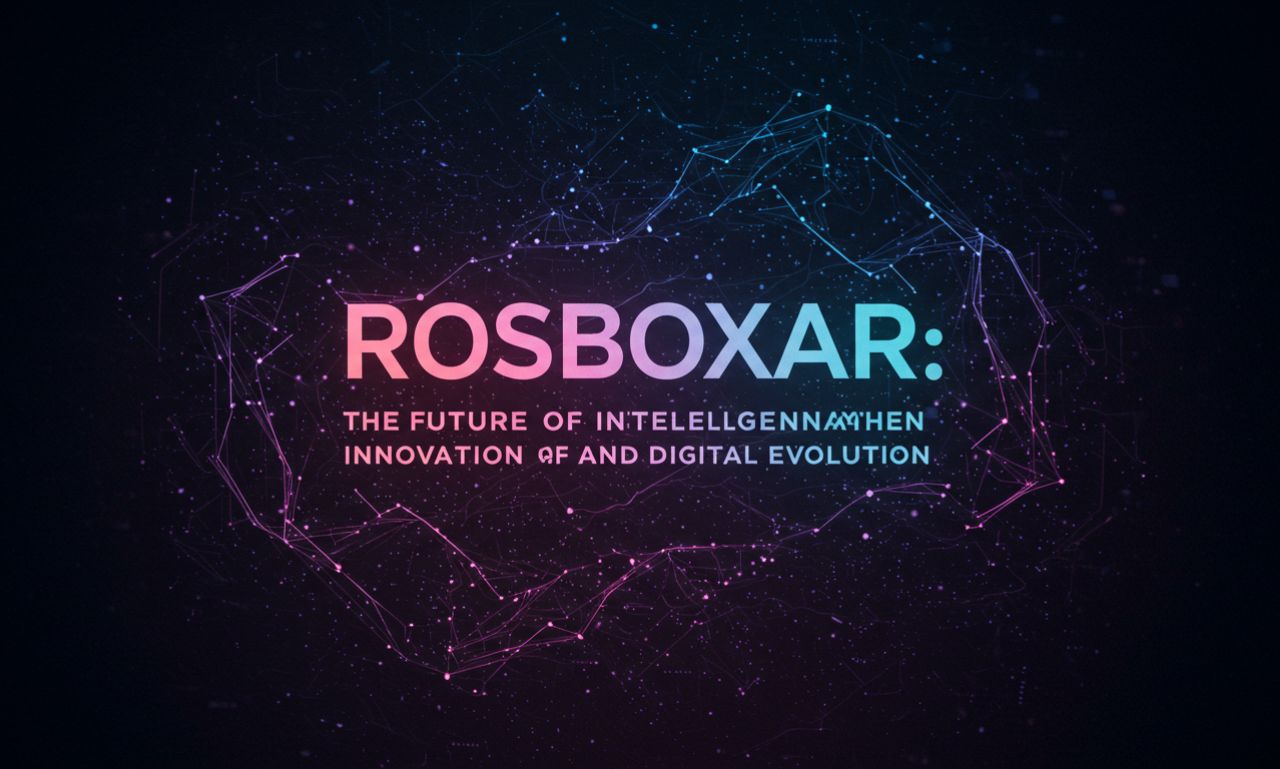In the fast-paced world of digital transformation, new concepts continuously emerge to describe innovation, intelligence, and adaptability. One such rising term is Rosboxar. Although not yet mainstream, Rosboxar has started to appear in discussions about smart systems, futuristic design, and integrated technology.
The name Rosboxar evokes curiosity—it blends mystery with progress. But beyond the name, Rosboxar represents a new generation of intelligent frameworks that combine creativity, data, and sustainability. This article explores what Ros boxar means, how it works, and why it’s becoming a symbol of digital evolution.
Understanding the Meaning of Rosboxar
What Is Rosboxar?
The term Ros boxar can be understood as a fusion of “Robotics,” “Systems,” and “Box Architecture.” It reflects the idea of modular intelligence—systems built in flexible units (“boxes”) that can communicate, adapt, and evolve.
At its core, Rosboxar represents:
-
Integration: Connecting multiple technologies into one cohesive system.
-
Adaptability: Learning and adjusting automatically based on input data.
-
Innovation: Constantly improving through feedback and machine intelligence.
Conceptual Meaning of Rosboxar
Conceptually, Ros boxar symbolizes digital synergy—the merging of human creativity and machine precision. It promotes an ecosystem where technology supports human potential rather than replacing it.
Whether in robotics, AI, or data systems, Ro boxar stands for smart innovation that learns, adapts, and evolves intelligently.
The Origin and Evolution of Rosboxar
The Birth of the Rosboxar Concept
The origin of Ros boxar can be traced to early research on modular robotics and artificial intelligence. Engineers and innovators wanted to create systems that were not only functional but also reconfigurable and autonomous.
Rosboxar emerged as a conceptual framework to describe digital entities that could think, learn, and cooperate with each other without constant human input.
Evolution in Modern Context
As technology advanced, Rosboxar evolved into more than just a robotics term—it became a philosophy of innovation. Today, it is associated with intelligent design systems, digital automation, and sustainable AI architectures.
In short, Ros boxar has transformed from a technical term into a vision for the future of intelligent adaptability.
Applications of Rosboxar in the Modern World
1. Rosboxar in Artificial Intelligence
Artificial intelligence forms the foundation of Rosboxar systems. These systems use advanced algorithms to process information, learn from user behavior, and adapt in real-time.
Key applications include:
-
Autonomous robots that self-navigate and adjust their performance.
-
Predictive analytics platforms that evolve based on new data.
-
Conversational AI that learns tone, style, and intent over time.
Ros boxar in AI promotes adaptive intelligence, where systems grow smarter through continuous interaction.
2. Rosboxar in Business Transformation
Businesses adopting the Ros boxar framework gain agility and innovation-driven growth. It allows organizations to operate in modular, interconnected structures, enabling faster decision-making and flexibility.
Key benefits of Rosboxar business models include:
-
Automation of repetitive tasks, improving efficiency.
-
Scalable architecture that adapts to new markets.
-
Data integration, providing real-time insights.
Through Ros boxar, enterprises can embrace intelligent transformation, becoming future-ready in competitive markets.
3. Rosboxar in Creative Industries
In creative industries, Ros boxar symbolizes the merging of art and technology. Artists and designers use Rosboxar-inspired methods to integrate digital tools, generative AI, and real-time interactivity into their work.
Examples include:
-
AI-generated art and design.
-
Immersive storytelling experiences using adaptive systems.
-
Smart creative tools that evolve with the artist’s input.
Thus, Ros boxar becomes a creative catalyst, empowering innovation through intelligent digital collaboration.
4. Rosboxar in Sustainable Technology
Sustainability is another key area where Ros boxar principles shine. With global concerns about energy efficiency and ecological impact, Rosboxar offers solutions for green computing and low-energy automation.
Rosboxar-inspired systems aim to:
-
Reduce waste in digital processes.
-
Optimize energy consumption in data centers.
-
Support circular technology economies.
In this sense, Rosboxar innovation ensures that digital progress aligns with environmental responsibility.
The Architecture of Rosboxar Systems
The Rosboxar architecture is modular and intelligent. It consists of interconnected units—“boxes”—that communicate through a shared AI framework. Each box can function independently but also contribute to the overall system intelligence.
Core Features of Rosboxar Systems
-
Self-learning algorithms that adapt through data input.
-
Scalable modules that can be upgraded individually.
-
Interoperability between different devices and platforms.
-
Resilient design ensuring system stability.
-
Real-time analytics for continuous improvement.
This distributed yet unified structure makes Ros boxar a model for future AI ecosystems.
The Rosboxar Mindset: Beyond Technology
A Human-Centered Approach
Rosboxar emphasizes the balance between automation and humanity. While machines can process data faster, creativity and empathy remain human strengths. The Rosboxar approach ensures that technology enhances, not replaces, human intelligence.
Ethics and Responsibility
As intelligent systems evolve, ethical AI becomes vital. The Rosboxar philosophy advocates for transparency, fairness, and accountability in all technological advancements.
By integrating ethical governance into design, Ros boxar helps maintain trust in the digital age.
Cultural and Social Impact of Rosboxar
Rosboxar as a Symbol of Digital Culture
In digital culture, Rosboxar symbolizes adaptability and unity. It reflects a global trend of humans collaborating with machines to create smarter societies.
This cultural movement promotes:
-
Digital literacy among all communities.
-
Inclusive innovation across social boundaries.
-
Open-source collaboration for global benefit.
Through Rosboxar, technology becomes not just a tool—but a shared human experience.
Rosboxar and the Global Economy
The Rosboxar economy is built on automation, intelligence, and adaptability. As industries digitize, Rosboxar frameworks help businesses cut costs, improve efficiency, and deliver smarter products.
This contributes to a data-driven global economy, where value is created through information, connectivity, and collaboration.
Challenges Facing Rosboxar Implementation
Despite its potential, Ros boxar systems face notable challenges:
-
Complexity: Building modular intelligent systems requires advanced expertise.
-
Security Risks: Interconnected AI units can be vulnerable to cyberattacks.
-
Ethical Concerns: Data privacy and algorithmic bias remain pressing issues.
-
High Costs: Initial deployment and integration expenses can be significant.
To overcome these obstacles, developers must focus on secure, transparent, and scalable architectures guided by ethical principles.
The Future of Rosboxar
Integration with Emerging Technologies
The future of Ros boxar lies in its ability to integrate with emerging technologies such as quantum computing, blockchain, and the Internet of Things (IoT). By merging with these domains, Rosboxar can create intelligent, decentralized ecosystems that redefine industries.
The Path Toward Autonomous Intelligence
In coming years, Rosboxar AI frameworks may evolve into fully autonomous networks capable of self-governance and optimization without human oversight. This would revolutionize industries ranging from transportation to healthcare.
Global Impact
As Rosboxar spreads across sectors, it will continue to shape:
-
Smart cities with AI-managed infrastructure.
-
Eco-systems powered by renewable digital technologies.
-
Human-machine collaborations that inspire creativity and innovation.
In essence, Ros boxar represents the blueprint of a smarter world—where technology learns, adapts, and evolves alongside humanity.
Conclusion: The Age of Rosboxar
The world is entering an era defined by intelligence, adaptability, and connection—and Rosb oxar stands at its core. From powering AI systems to transforming creative industries and driving sustainable innovation, Rosboxar represents the future of intelligent design.
By embracing the Rosboxar philosophy, societies can move toward a more connected, ethical, and forward-thinking world—where technology amplifies human potential rather than replacing it.
As innovation continues, one thing is certain: the Ros boxar era has just begun, and its impact will redefine how we think, create.

